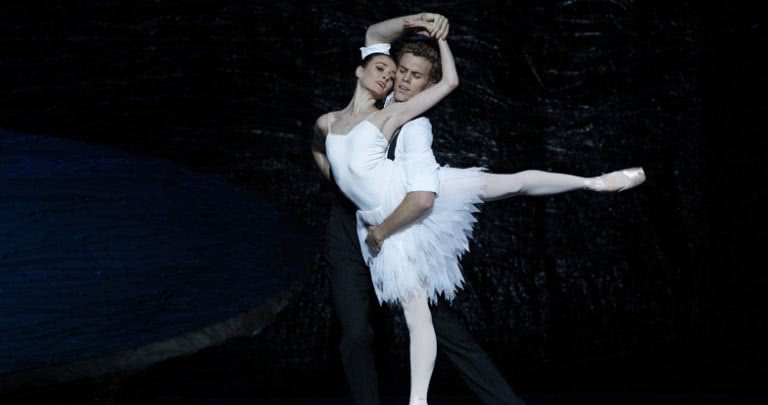If you’re heading to the Capitol Theatre to see the Australian Ballet’sSwan Lakethis month, it will be nothing like what your nan or the 1994Swan Princesscartoon prepared you for. Graeme Murphy’s reimagining subverts Tchaikovsky’s 1875 canonical classic in every conceivable way. Neither the plot, score nor costumes have escaped unscathed, which is incredibly refreshing. And you have to respect anyone who has the gall to overtly imply an orgasm on a ballet stage. The BRAG chatted to principal ballerina Amber Scott about the show and what makes it so unique.
This version of Swan Lake has already been around for 12 years and its return to Australia is almost a tradition in itself. Despite this, new audiences may find the characters and plot somewhat reminiscent of real people. “The inspiration that Graeme Murphy and Janet Vernon had initially was the love triangle between Camilla Parker Bowles, Prince Charles and Diana,” Scott explains. “Because that was in a royal court situation, it fitted perfectly with the ballet story. It starts off with the wedding, and Odette is the Diana character; she’s very innocent and young. Charles is the prince getting married for the right reasons but his heart is with Camilla, who is of course the Baroness von Rothbart.”
The differentiation between the traditional and modern will be immediately evident to audiences, particularly as this new Swan Lake begins where the old ended – at least in the happier versions where the characters don’t commit suicide, anyway.
“Act One is a big one for all the characters,” says Scott. “It’s where Odette, at her own wedding, discovers the prince’s infidelity. She’s already a fairly fragile and delicate person so it sends her literally mad. She’s sent off to a sanitarium, which is very convenient because it means that the prince and the baroness have all the time they want to continue their affair.”
This is certainly one of the most significant changes in Murphy’s appropriation. One could argue that perhaps poor Prince Siegfried is getting somewhat of a character assassination. In the original he is merely tricked, whereas here he is knowingly committing an act of betrayal. Scott has a fascinating perspective on this.
“I think there’s a few ways that Siegfried can be portrayed in this version, and it’s always interesting when I watch different performances,” she says. “I know that my partner Ad [Adam Bull] doesn’t think of him so much as a villain. I think that by the end of the ballet he feels like he truly made a mistake. He’s at a loss and he loses everything.
“Other people who I’ve seen play it are more caddish and quite aware of what they’re doing. I think that in the end Siegfried is just a human and he’s succumbed to temptation. He’s a prince but he makes mistakes that people in everyday life make.”
In this way, Murphy’s Swan Lake is dismantling the traditional fairy story. I wonder out loud whether this version is more realistic and perhaps made all the more important by the affair.
“It’s clever really, because everyone is aware of it at the court, but it’s just not talked about,” says Scott. “I think in that way Graeme has created a very different, and quite human situation in Act One, as opposed to a traditional, classical ballet where there is a lot of pomp and ceremony but not a lot of emotion.”
Despite the vast changes to the story, audiences will still be able to recognise elements of the traditional Swan Lake in Murphy’s adaptation. “In Act Two, Odette is in an institution and she’s looked after by nuns who are all dressed in white and are very Swiss,” Scott explains. “They have enormous hats, and she thinks they are like swans, so she suddenly imagines that she’s become one. The whole second act is an ode to the traditional; there are the signets and the big swans and a beautiful pas de deux solo. There are a lot of elements that are taken from the traditional and are paying homage to that.”
It’s well-known throughout the dancing world that the role of Odette is one of the most tiring and all-consuming in all of ballet, and Scott can certainly confirm that. “We know Graeme’s choreography inside out now, but there’s a level of getting your body strong enough to do it, because it is one of the most demanding roles I’ve done,” she says. “It’s about doing the hours in the studio and working with your partner. A lot of the ballet is really heavy partnering, and the men are amazing with what they do with the girls. I still don’t know how they do it. I look in the mirror sometimes and I’m like, ‘What?!’” she laughs.
Scott has had a great deal of experience dancing both the traditional and the modern versions of Swan Lake, so she’s in a good position to compare. “I find that both versions help each other. I’ve been able to bring physicality from one to the other and it’s been quite interesting. They’re not completely dissimilar characters; Odette is fragile and tragic in both versions. But I think ultimately it’s not so much the dancing, but the depth of the story that I love. It’s been an honour to be able to perform something like that where you can just let everything out; I think that’s what gets you through.”
Graeme Murphy’s Swan LakeatCapitol Theatre fromFriday February 20 until Saturday February 28, tickets online.

































